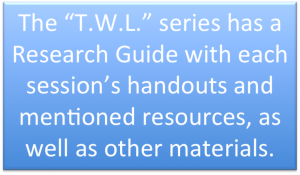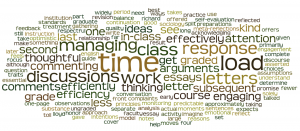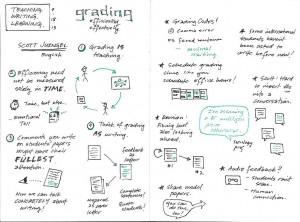Last Week’s “T.W.L.” Conversation on Teaching Writing: “Grading Is Teaching”
by Nancy Chick, CFT Assistant Director
Scott Juengel (English) talked about “Managing the Paper Load: Grading Writing Efficiently and Effectively” with approximately 30 faculty, staff, graduate students, and undergraduate students on September 18. This lunchtime gathering was the second in the “Teaching. Writing. Learning.” series of conversations on teaching writing.
 Although he’s been at Vanderbilt for some time, he came from an institution where he taught a large course that gave him 75 papers during each grading period. (He split the grading load for 300 students with his three TAs.) Based on his experiences with that course and his subsequent courses at Vanderbilt, he offered four principles or assumptions that determine his unconventional approach to ‘managing the paper load’ and ‘grading writing efficiently and effectively.’
Although he’s been at Vanderbilt for some time, he came from an institution where he taught a large course that gave him 75 papers during each grading period. (He split the grading load for 300 students with his three TAs.) Based on his experiences with that course and his subsequent courses at Vanderbilt, he offered four principles or assumptions that determine his unconventional approach to ‘managing the paper load’ and ‘grading writing efficiently and effectively.’
First, he asserted that “grading is teaching.” Rather than thinking of it as a separate activity, he approaches his grading and commenting on students’ essays as an essential part of instruction. He also sets aside time for grading in the same way that he does for class preparations, and he designs in-class activities to reflect and practice moves he looks for in his students’ papers. This last point echoes Richard Lloyd’s (Sociology) comments about the relationship between in-class discussions and student writing at last month’s “Teaching. Writing. Learning”: “the quality of class discussions is reflected in predictable ways in the writing I get from students.” “

Second, he challenged us to reconceptualize “efficiency” when it comes to managing the paper load: “efficiency need not be measured solely in time.” While it still takes him no less than 30 minutes to grade any given paper, he notes that his attention to thoughtful, engaged reading and commenting on his students’ work “cuts down on my own emotional toll.” Returning graded papers feels more like continuing a respectful conversation with each student, rather than delivering a blow to their egos. As a result of taking his responses to their work this seriously, he also gets far fewer grade complaints, suggesting that his students understand and honor his grading standards.
Third, despite our best intentions of engaging our students during class time, “our comments on their papers might be the moment we have their fullest attention.” Until they have a graded essay in front of them, our discussions of good writing make less of an impact. [This is one of the primary arguments for assigning ungraded diagnostic writings very early in the semester.] Scott uses these moments of intense engagement—when students most see that “something of substance hangs in the balance”—to focus on the students’ ideas and arguments and offers this feedback in the form of a single-spaced, one-page letter. (See his samples at the “T.W.L.” Research Guide.) Later, in response to a question, he pointed out that engaging primarily with the students’ ideas in these letters—rather than a line-by-line set of criticisms or corrections—means they don’t take long to write.
Finally, in describing his letters to students, he illustrated that he “thinks of his response to student papers as a model in itself”—with complete sentences, details and actual quotes from their essays to support his observations and evaluations, and other traits of effective writing he expects from his students. In response, students include cover letters with their revisions or subsequent writings as “meta-reflections” that help them “own the process of revision” by responding directly to his letter and to their own choices in writing. [This kind of self-evaluation and -analysis of their own learning is widely supported by the research on metacognition, or monitoring their own thinking. For more information, see the CFT’s guide on metacognition.] He also described his use of “the discourse of potential,” acknowledging that “all papers have promise.” [I imagine this kind of thoughtful, optimistic treatment of their work is one of the reasons he doesn’t get pushback from students at grading time.]
After these opening remarks, I shared a handout with a sample of a minimal approach to grading surface or mechanical issues in writing and introduced the research showing that students often don’t read and interpret our feedback on papers in the ways we think or want. (Scott’s approach to  feedback as a conversation with students is one of the ways around this challenge.) Elizabeth Covington from the Writing Studio reinforced Scott’s comments and practices that help students understand that writing is a process, such as the epistolary conversation that begins with the students’ first writing, as well as the continuity in expectations of behavior between the way students discuss in class, read their texts, and write their essays. [Emily King (English) from the previous “T.W.L.” session also talked about this foundational concept.] Melinda Brown from the Library connected to grading student writing by focusing on the citations: because the majority of research is now done online, students’ citations should reflect these origins of their sources. If they cite primarily hard copies (unless the assignment obviously calls for using hard copies), it’s worth noting that either the work isn’t original or students don’t understand the citation process and style. Susan Barone of the English Language Center asked us to keep in mind that international students spend a great deal of time on their essays and on trying to understand our feedback, and that for some of them, ours is “their first experience with academic writing,” so we can’t assume they come in knowing our expectations. [Nor should we assume that any students come in knowing our expectations.]
feedback as a conversation with students is one of the ways around this challenge.) Elizabeth Covington from the Writing Studio reinforced Scott’s comments and practices that help students understand that writing is a process, such as the epistolary conversation that begins with the students’ first writing, as well as the continuity in expectations of behavior between the way students discuss in class, read their texts, and write their essays. [Emily King (English) from the previous “T.W.L.” session also talked about this foundational concept.] Melinda Brown from the Library connected to grading student writing by focusing on the citations: because the majority of research is now done online, students’ citations should reflect these origins of their sources. If they cite primarily hard copies (unless the assignment obviously calls for using hard copies), it’s worth noting that either the work isn’t original or students don’t understand the citation process and style. Susan Barone of the English Language Center asked us to keep in mind that international students spend a great deal of time on their essays and on trying to understand our feedback, and that for some of them, ours is “their first experience with academic writing,” so we can’t assume they come in knowing our expectations. [Nor should we assume that any students come in knowing our expectations.]

Participants asked about managing grading time, the use of rubrics (especially those with numerical grades associated with the criteria), and the logistics of Scott’s grading process. Some discussed the use of audio feedback to student writing, as well as managing expectations that “every paper starts in the B- or C+ range.”
For an additional glimpse into the conversation, see CFT Director Derek Bruff’s sketchnotes (preview right).
For follow-up help, advice, or conversation, please contact us for the following types of consultations:
- the Writing Studio: any issue of teaching writing
- the Center for Teaching: any issue of teaching and learning
- the English Language Center: how to adapt instruction to international students
- the Jean & Alexander Heard Library: research-related consults and purchasing requests to support teaching.
The Next Conversation?
The next “Teaching. Writing. Learning.” session will focus on “Writing and the Masses: Writing and Large Lecture Courses” with James Fraser (Human & Organizational Development). Join us on Tuesday, October 22, from 12:30 to 1:30 in the Community Room of the Central Library.

Leave a Response